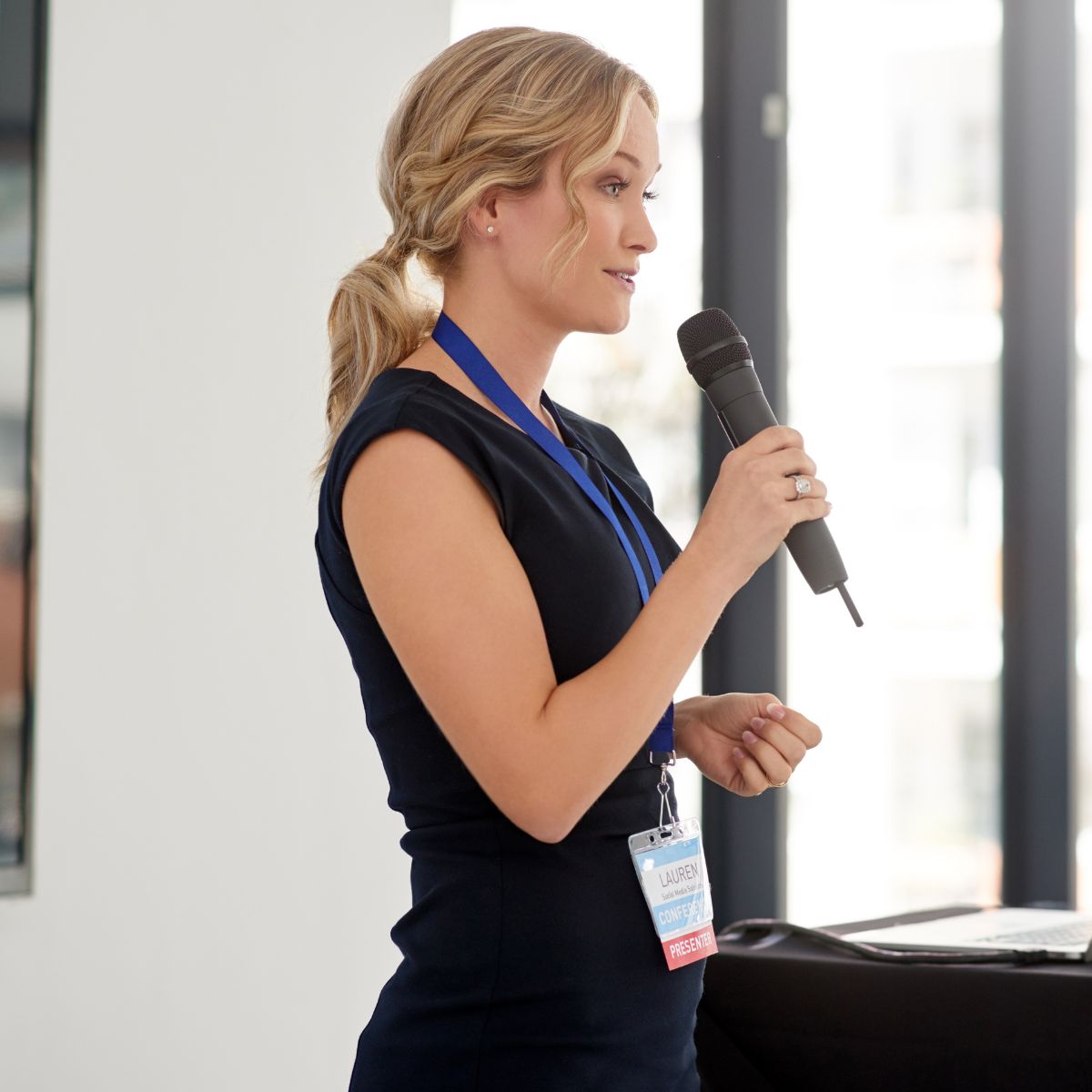Ways in which we sabotage ourselves when we speak in public
Women can be spectacularly successful in sabotaging themselves when they stand up to speak in public – and even before they stand up.

I learned about when we speak in public most powerfully when I first started networking 13 years ago.
I attended a networking meeting. As one of three women in the room of twenty men, we embarked on the usual, and sometimes an excruciating round of introductions. Not everyone was good at this, as is often the case. We had the mumblers. The ramblers, sleazy sales, the ones who couldn’t explain what they did. And the ones who loved the sound of their own voices.
In other words, it was a typical networking meeting as I had experienced it at that point in my business.
There were some introductions though that did have an impact.
Some pitches stood out and were helpful in helping us understand what that person did. One of those was mine. And there was a woman who I got to know well and ended up collaborating with.
Presentations that stay in my mind for the wrong reasons
And then the third woman stood up.
Her pitch was so markedly different that it has forever stayed in my mind.
She hesitated.
Spoke quietly.
Apologised for her voice, her cold, her business.
She was unclear, but unlike the other attendees who also hadn’t been clear, she came across as lacking in confidence and credibility.
As her pitch ended, she smiled nervously and sat down with no eye contact.
Why do I remember this so vividly?
She was nervous and so are many. I’d hazard a guess that a fair few people in that room were nervous, including me at the time. She did certain things that I’ve noticed since that women typically, but not exclusively, do. And I think it is a shame.
So, what did she do?
The apology
Well firstly, she apologised. Frequently.
Unnecessarily and so often that the impression given was that the business itself needed apologising for.
This apparent need to apologise is not just confined to networking introductions of course. Listen out in meetings or briefings or even in telephone conversations and there are an alarming number of cases where the opening gambit is, ‘ I’m sorry but…’, ‘sorry, could I just…’, ‘forgive me, but’.
When we start with apologising, then it is easy for those insidious pair of words – a little bit – and just – to creep in as well.
“Sorry, I’d like to tell you a little bit…”
“I’d just like to …if that’s alright…”
“If I could just have your attention.”
There are times when it is correct and polite to check out the best time to say things, but many times, when we speak in public it is more a reflection of an inner lack of confidence or uncertainly, that shows itself in the words that we use.
‘A little bit about’ and ‘just’ are two words and phrases I want to have banned from public speaking.
We are either talking about something or not. When we introduce the word just into any sentence then it immediately reduces the impact of what we are talking about.
How we stand when we speak in public
Secondly, she stood in a way that diminished her impact rather than creating a presence. This is so common, that we don’t even realise it until we see a woman doing it differently.
What do I mean?
Her legs were crossed, her shoulders brought forward.
With hands close to her chest she gave the impression of praying rather than open sharing.
Her head was on one side as if questioning her right to be there and her weight shifted from hip to hip.
Is this cruel to point this out?
“When we stand up to speak, we have an opportunity to create a presence.”
If we want our talks to make an impression, then we need to do this intentionally and skillfully. This applies to men and women of course, but especially women because there are a whole lot of messages and cultural signals we often unconsciously adopt.
Keep your legs close together. Make yourself smaller. Don’t take up lots of space. Check to see if you’ve offended anyone.
In my workshops, I teach speakers to adopt a Speaker Stance – feet a hip-width apart, elongated spine, head upright and hands loosely held at waist height, ready for action. Men don’t always stand like this either but they are often much quicker at being able to get into Speaker Stance. It takes women longer – placing our feet apart feels weird. We often don’t even realise our head is tilted until someone points it out.
Does this really matter when we speak in public?
Well, yes.
How we stand, and especially at the beginning, sends out many messages about our confidence, our competence, and our credibility.
Why would we want to sabotage that right from the beginning of our talks and then reinforce those negative responses throughout?
And it is one of the easiest ways to reverse this self-sabotage.
“Stand tall, stand proud. Without apology. With presence.”

Pleading with the audience
There is another subtle way that women can self-sabotage when they speak in public. In a possible desire to please rather than influence, we use smiles and eye contact to plead. Smiling and eye contact are indeed crucial elements of great speaking – but only when that comes from a place of connection.
I have fallen foul of this one myself when I was a newly appointed Senior HR manager for a large international company. When my presentation to the sales force bombed spectacularly and I realised I was on a sticky wicket, I resorted to pleading. Eyelash fluttering, high-pitched speaking, desperate smiling.
“It was not my finest hour.”
And I have seen this played out again and again. It is why I love working with clients to first get the message right, so there is no need to plead. But also, how to deliver in a way that builds a connection with the audience and where the content resonates with them. Real influence and persuasive language rather than pleading.
Of course, I should and do give credit to the woman at the networking event who did stand up. There are many who don’t even show up. And perhaps this is the most insidious way that women self-sabotage.
“I have had many women admit to me that they would rather not attend a networking event with all the advantages and opportunities that offers their business, than stand up and speak – even if that is only for 60 seconds.”
The three reasons stopping people from standing up
And I get it. Over the twenty-five years I have been doing this work, helping people to speak in public, I believe there are three key reasons that get in the way of people, and especially women, standing up and speaking up. They:
1) don’t know what to say or how to say it and in the absence of not knowing, say nothing.
2) know what to say but don’t know how to say it and therefore let others say it instead or let the moment pass.
3) know what to say and they can say it…but no one pays the slightest bit of attention.
Why would I say that this affects women more than men?
Why would I say that this affects women more than men? There is plenty of anecdotal evidence that I have seen that suggests even when men don’t know what to say or how to say it, they’ll say it anyway. The men I have spoken to will often admit that it isn’t perfect, but they are still happy to put themselves forward. I remember the first time I read Sheryl Sandberg’s book Lean In and realised that on so many occasions, women lean out when they could be leaning in…and that some of this was to do with wanting to be fully prepared, fully perfect and holding themselves back time and again.
In a simplistic way, if we hold ourselves back, then we run the real risk of being the world’s best kept secret. If you only wait until we are ‘perfect’ then the moment of opportunity can pass us by. When we lean out, then someone else ( and maybe someone not as good as you) will lean in.
So where does this leave us?
There are things we can do as women that make all the difference to the impact and the influence we can have.
It starts off with the voice inside our heads.
This voice often tells us to keep quiet and challenges our right to have something valuable and worthwhile to listen to.
Creating a shift to more confidence comes when we think, not in terms of what we have to say, but in terms of what they need to hear. Starting off the whole preparation process by thinking about the audience reinforces and highlights that we have something of value to say.
I do not always talk about confidence in my workshops and coaching.
How can you become more resourceful?
Asking yourself, ‘how resourceful am I right now to deal with this situation?’, allows us to go searching for resources if we are less than resourceful at that time.
If you don’t feel confident, there’s nowhere else to look. If you feel less than fully resourced then you can always access more – through posture, breathing, connecting with the audience, pausing, checking your prompt cards, being present.
Creating presence doesn’t mean that we must stride aggressively around the stage or stand like Lord Flash Heart from Blackadder. But we do need to claim our space and take up space so that people can listen and hear what we have to say. Thinking about our posture, and ensuring that we can be seen and heard is part of the ‘Performance -Ready’ routine I teach.
In a recent workshop, I ran for women, there was an epiphany moment for several women when they realised that they hadn’t allowed themselves to connect with the message they were delivering. Not only that but they hadn’t been making it meaningful for their audience, either. No wonder the doubts and anxiety had crept in. It was liberating and empowering to connect first to their passion and second to their audience. The results were electrifying. Power and passion and personality demanded and claimed from the get-go.
“It is time to say goodbye to the sabotage. It is time that women claimed the space they deserve and stand up to be heard.”
If you’d like to know more about my coaching, please click here.